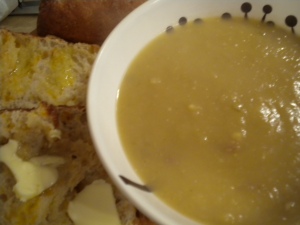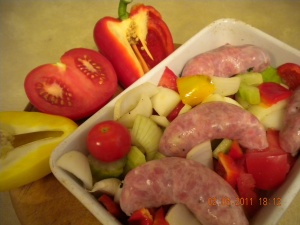Amid the melee of half a day’s work, a visit to my mum and dad, the handing over of the first goose eggs to a more experienced, better equipped hatcher, and helping to feed seven pet lambs, I managed an hour’s lunch with a lovely lady at a very nice cafe near where we used to work together.
Truly Scrumptious is an attractive cafe in Stramongate, Kendal (Cumbria, the centre of my world). It’s got a slightly Continental-but-in-London look about it (though as we’ve established, it’s 271 miles north of London), pretty things adorning the walls, mixed up pink, cream and yellowy tones, blackboards along the longest wall. There’s even the odd bit of gingham in the shape of a bunting flag or two. That’s right: it’s a cafe with bunting. Indoors. Very nicely done.

 It’s also got the number of tables right. They’ve shoehorned about ten or eleven square tables into the space, each with at least a capacity for two people. What this creates is that noisy, busy atmospheric that Italian restaurants are so good at producing (it isn’t Italian, though there is pasta on the offer). It can be a bit awkward getting round people to sit down, but elbow room is plentiful once you are seated.
It’s also got the number of tables right. They’ve shoehorned about ten or eleven square tables into the space, each with at least a capacity for two people. What this creates is that noisy, busy atmospheric that Italian restaurants are so good at producing (it isn’t Italian, though there is pasta on the offer). It can be a bit awkward getting round people to sit down, but elbow room is plentiful once you are seated.
Their food is lovely but I found it surprising that they hadn’t changed their menus. I don’t think there was even a Special which was a new idea. Since I started going to them in April 2012, their blackboards have always boasted cheese tortellioni, lasagne, cottage pie, chicken liver pate, something with goats cheese, something with either smoked or poached salmon and cream cheese, and soup of the day. Now, doesn’t that all smell lovely? It is.
Soup of the day is regularly changed. Perhaps that’s partly why my friend always chooses it. Also she knows I don’t do soup when I’m out and her lunch will not be stolen from her. I prefer to eat out on food I can’t or don’t cook.
The main menu is thematic: goats cheese and onion marmalade, smoked or poached salmon with cream cheese, chicken and mango, greek feta and olive. All these are paired with staples of a modern cafe; baked potato and a good sized side salad, or large salad, or theme sandwich with a large salad, and presented beautifully.
The whole format obviously works very well for them. At lunchtime most people just want to get on back to work, or talk to each other. (Not me – food comes first – but I know plenty. Some of them are my best friends.) Knowing the menu and trusting the quality helps this.
I think the pleasance of the product offsets any sameness. Everything is nicely designed and arranged. It’s not always practical – my side salad needed dumping on my plate before the whole thing landed in my friend’s lap – but it’s so pretty; you can forgive a lot for beauty.
So, enough ramble preamble. Introducing …. Lasagne and salad:
And Onion Soup with a scone:
Top two images C/O Google
54.577232
-2.797483









